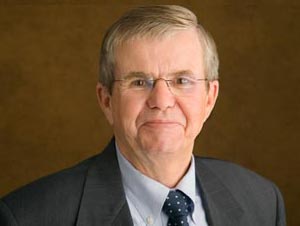As the end of the academic year approaches, I would like to express my appreciation for your commitment and dedication. Thanks to your hard work, another class of students will soon leave the university prepared to take on new challenges and further explore their capabilities.
There is much to celebrate this time of year. Our dynamic university continues to flourish and fulfill every obligation of its public mission while extending a rich tradition of accessible education and community service. We have reinvigorated ties to alumni and recharged our athletics programs. We reinforced our international reputation and invested more resources in our drive for sustainability. In short, we have honored our priorities at every level.
The year brought notable reminders that NAU operates on a global stage, and that an important role for a university is to nurture big ideas with broad impact. From the work of individual researchers such as Paul Keim, whose expertise informs us on health topics of worldwide importance, to NAU’s participation in major climate change research, we demonstrated our relevance to the major issues of today. Our efforts to interweave intercultural and global learning into the curriculum brought the university the prestigious 2012 Sen. Paul Simon Award for Comprehensive Internationalization from NAFSA: Association of International Educators.

Since the official opening of the Lumberjack Mathematics Center, first-year students have tackled math concepts through adaptive, assessment-based learning modules and hybrid instruction. With continuous assessment that helps fine-tune our first-year mathematics, the center is poised to improve student progress toward a baccalaureate degree.

Yet technology as a finely honed educational tool is only part of the new landscape. The credit-hour system of attaining a degree is quickly—and, perhaps, permanently—shifting toward assessment-based learning.
By early June we anticipate the Higher Learning Commission will green-light Personalized Learning—a self-paced, competency-based online program using predictive learning analytics to adjust instruction to individual student needs. With a tuition rate set at $2,500 for six months, the program will enable motivated adult students to earn a high-quality degree more efficiently and at a lower cost. Our work on this program was jump-started by a $1 million grant from the Gates Foundation.

As we hold to our core values while adapting to new outlooks and approaches, even further innovation is needed to reach students effectively. We must do so while facing up to the realities of modern higher education: dwindling state resources, tuition approaching the market maximum and performance metrics. Volumes are being written about how to approach these challenges, and in particular I recommend William Bowen’s Higher Education in the Digital Age for your summer reading.
Some projects to address these issues at NAU are well under way. For example, the Faculty Senate has worked over the last year to articulate university-level learning outcomes, enhancing our accountability to students and taxpayers. But we need more ideas and a willingness to take some risks. My own Technology Initiative encourages this approach. The initiative has infused funding into technology enhancement of large enrollment multi-section courses from every college—and the first results have shown great promise. We must strive for efficiency, for we simply no longer have the resources to fund multiple designs by multiple instructors for the same course. Instead, our model should be a single design, optimized through the collaboration of faculty colleagues, with specific learning outcomes letting students know what they can expect to gain.
We also need new insights about those outcomes. With federal policy shifting toward, and accreditation agencies slowly embracing, competency-based education, we can expect less emphasis on how students are taught and more on what they learn. This combined with still-in-play performance funding, a national conversation about gainful employment policies and likely financial aid reforms provides additional incentive for the university to get ahead of the game and stay there.
Clearly, we have much work ahead of us. Some of it is as fundamental as our building infrastructure. While voter-approved funding through the state lottery allowed the university to invest in new buildings, the state has not appropriated any funds for building renewal since 2008. Our deferred maintenance is more than $109 million, and we spend about $3 million annually to address the most acute safety and health issues.
As we look forward to what the next academic year may bring, we have an opportunity to renew our collective commitment to excellence: in undergraduate education, in graduate studies and research, in high performance and the rewards that come with it. The opportunities that lie before us do not present themselves often. I encourage you to embrace the potential that exists when talent and focus meet a world vibrant with change.



